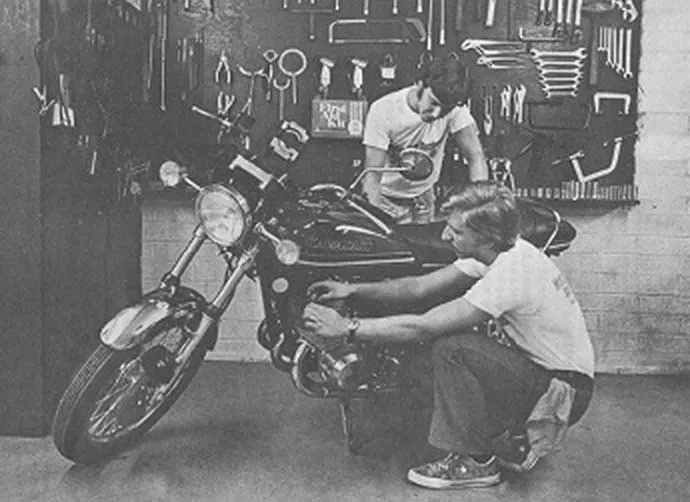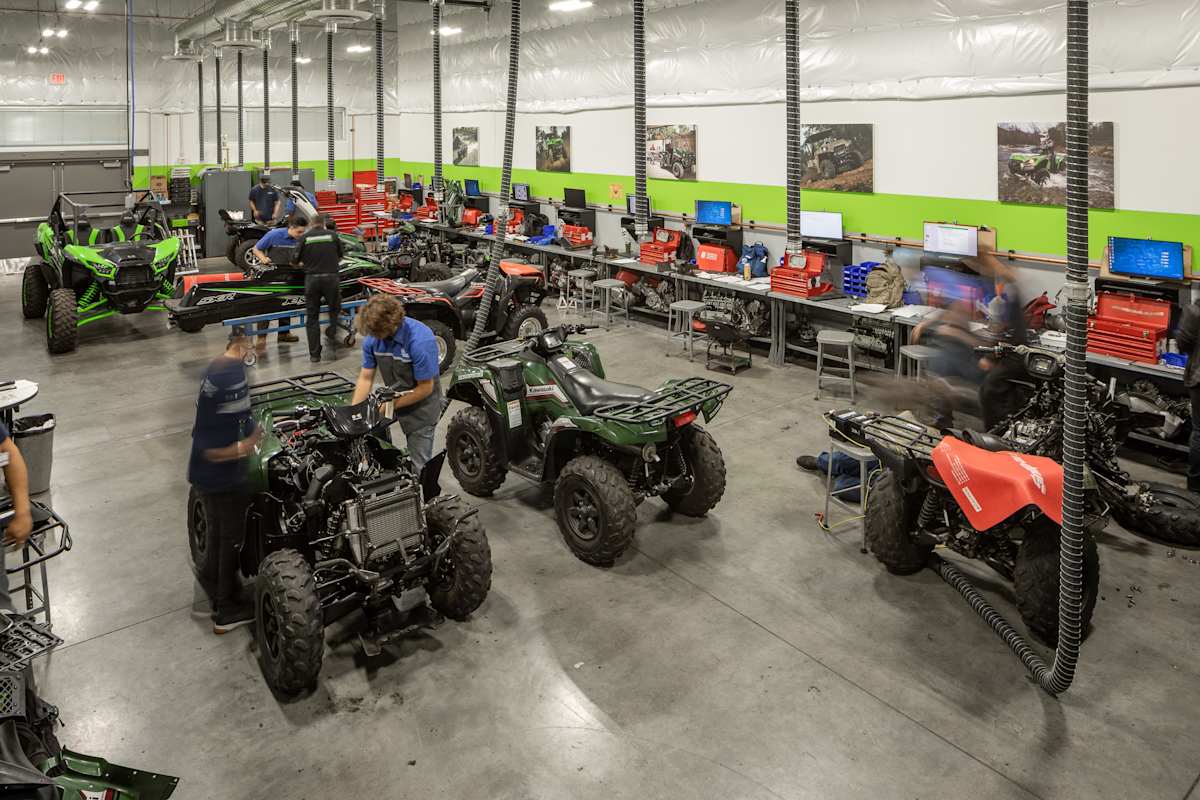The History of Yamaha Motorcycles
Dive into Yamaha history and discover the brand’s impact on the industry. Get details about this top motorcycle manufacturer’s iconic past!
In 1878, Shozo Kawasaki founded the Kawasaki Tsukiji Shipyard in Tokyo, Japan—the site for technological innovations for the shipping industry.
Then came the 1960s, when Kawasaki dipped its toes into the motorcycle industry. It produced its first bike in 1962 and soon merged with the Meguro Manufacturing Co. to form Kawasaki Motorcycle Co., Ltd., in 1963.
Since then, Kawasaki has been a popular name in the industry and has stood the test of time while producing a range of motorcycles. The brand and Universal Technical Institute (UTI) developed a relationship that led to the creation of the K-Tech specialized training program in 1989.
Keep reading to learn more about Kawasaki history, as well as the specialized training opportunities available at UTI!
Read: The History of Suzuki Motorcycles
Kawasaki Heavy Industries, Ltd. (KHI) is the parent company that owns the Kawasaki brand, including its motorcycle division. Established in 1896, KHI is a conglomerate with diverse interests ranging from aerospace and shipbuilding to construction machinery and energy. Although the motorcycle division is just one part of its vast operations, it plays a significant role in defining the company's identity, particularly in the world of motorcycles where it has built a reputation for performance and innovation.
In recent years, Kawasaki has fostered partnerships within the motorcycle industry, collaborating with various firms to enhance technology and expand its product offerings. Notably, Kawasaki has formed joint ventures to leverage expertise in electric and autonomous vehicle development, signaling a strong commitment to adapting to changing market demands. This dedication to innovation and growth underpins Kawasaki's position as a leading manufacturer in the two-wheeled segment, ensuring that its legacy continues while paving the way for exciting future developments!
Kawasaki motorcycles are primarily manufactured in Japan, where the brand has its main production facilities. Additionally, they maintain plants in other countries such as the United States and Thailand, ensuring they meet the diverse demands of a global market while still upholding their high standards of quality and performance.
Read: Harley-Davidson® History: How It Became an Iconic Brand
Shozo Kawasaki had been interested in the marine industry from an early age, which is why he wanted to get involved in producing modern innovations for Japan’s shipping industry. It wasn’t until 1878, after struggling for some time, that the first order was placed with his company.
The business moved to Hyogo in 1886 and was renamed Kawasaki Dockyard Co., Ltd., as it continued to grow and demand for shipping rose. By 1906, the products Kawasaki manufactured began growing beyond the shipping industry. The company would eventually produce components for the automotive, railway and aviation sectors.
The Kawasaki Aircraft division became involved with the motorcycle industry once it started working with Meguro Manufacturing, which had been producing bikes since 1935. The two companies joined forces to form Kawasaki-Meguro in 1962.
They produced the first Kawasaki bike, the B8, that same year. It featured a single-cylinder, two-stroke, air-cooled engine. In 1963, Kawasaki took full control and formed Kawasaki Motorcycle Co., Ltd.
We’ve put together a Kawasaki motorcycle timeline to showcase some additional models produced throughout the decades.
1963 B8M: The B8M was also known as the “Red Tank" Kawasaki and was manufactured for competing in motocross events.
1967 A1: The A1 was a 250cc street bike that was the first in its class to feature an air-cooled, two-stroke, parallel twin engine.
1969 H1 Mach III: With American riders demanding more horsepower, Kawasaki released the H1 Mach III, which was a 500cc, two-stroke sport bike. It was very popular in the United States thanks to the combination of high power and affordability. It was considered the most powerful production motorcycle in the world for a time.
1972 Z1: The Z1 began being sold outside of Japan in 1972, with domestic versions following in 1973. The Z1 was the world’s first air-cooled, DOHC, in-line four engine. It was code-named the “New York Steak” during its five-year development.
1977 Z1-R: The Z1-R was the first-ever Japanese café racer and featured a stylish appearance that became popular overseas.

1982 GPz1100: This sport touring motorcycle had digital fuel injection (DFI) and Uni-Trak rear suspension, as well as an in-line, four-stroke, liquid-cooled engine.
1984 GPz900R: Known as the Ninja in the U.S., the GPz900R was named “Bike of the Year” by publications around the world. The model featured the first liquid-cooled, DOHC, 16-valve, four-cylinder engine and a unique look that set it apart from other bikes in the industry.
Read: From Tinkering on Bikes to Getting Paid for Motorcycle Work
1990 ZZ-R1100: Also known as the Ninja ZX-11 in North America, this bike had a high maximum power output and featured the first “Ram Air System.”
1997 Super Sherpa: The Super Sherpa was released as a dual-sport motorcycle and featured a 249cc, four-stroke engine. The bike’s multipurpose off-road performance made it a popular model.
2000 Ninja ZX-12R: The newest Ninja became the flagship model of the brand and featured the first mass-produced aluminum monocoque frame.
2006 ZZR1400: Also known as the Ninja ZX-14 in North America, the sport bike was touted as the most powerful ever produced by Kawasaki. Able to reach 60 mph in 2.5 seconds, the bike balanced performance and handling.
2011 Ninja ZX-10R: This was the first complete redesign of the ZX-10R since its initial release in 2004. It featured a new engine and frame, among other upgrades.
2014 Z1000: The fourth generation Z1000 debuted with a new look and feel. Upgrades included a new SFF-BP front suspension and increased direct response from the engine and chassis.
These are just a handful of the motorcycles produced by Kawasaki over the years. The brand continues producing high-quality bikes, which students get the chance to train on in the K-Tech manufacturer-specific training program at UTI.
Read: From NASCAR Fan to NASCAR Professional
The Kawasaki K-Tech program was endorsed by Kawasaki Motors Corp. in 1989, giving UTI students the opportunity to expand their training by enrolling in the manufacturer-specific course.
Once students have completed the moto mechanic courses from the 18‑week Motorcycle Technician Prerequisite (MTP) program at UTI, they are eligible to apply for the 12-week K-Tech program, which is split up into four different modules:
Offered at two UTI campuses, the K-Tech program offers unique features to students who want to work with one of the biggest names in the motorcycle industry. Benefits of the program include:

Read: From Couch-Surfing to Working in the Racing Industry
Kawasaki motorcycles are predominantly manufactured in Japan, where the company has its main production facilities. However, Kawasaki also has manufacturing plants in other countries, including the United States and Thailand, allowing them to cater to various markets efficiently.
The motorcycle division of Kawasaki has its roots in the company’s founding in the late 19th century, originally focusing on shipbuilding. It wasn’t until the 1960s, after merging with Meguro Manufacturing, that Kawasaki officially began producing motorcycles, starting with the B8 model in 1962.
Some of the most iconic models include the Kawasaki Z1, known for its revolutionary four-cylinder engine, and the Ninja series, which has been synonymous with high performance since the 1980s. Models like the H1 Mach III and the ZX-11 pushed the limits of speed and power, establishing Kawasaki as a dominant force in the motorcycle industry.
Kawasaki employs rigorous quality control measures throughout the manufacturing process, including advanced technology and skilled craftsmanship. Each bike undergoes extensive testing to ensure performance metrics and safety standards are met, ensuring that every motorcycle is built to last and performs exceptionally.
Kawasaki has made significant contributions to the world of motorcycle racing, with its models frequently dominating key competitions like MotoGP and World Superbike. The company’s commitment to innovation and performance has led to the development of high-performance racing bikes that not only showcase their engineering prowess but have also elevated the brand's global reputation in motorsports.
If working as a motorcycle technician is something that interests you, and you’d like to get specialized training working with Kawasaki, check out the K-Tech program at UTII! Manufacturer-specific training can help prepare you for a career working at a Kawasaki dealership.1
You can complete the elective program in just 12 weeks, once you’ve finished the core Motorcycle Technician Prerequisite (MTP) program. Find out more about both programs by requesting information here or by calling 1-800-834-7308.
Universal Technical Institute of Illinois, Inc. is approved by the Division of Private Business and Vocational Schools of the Illinois Board of Higher Education.